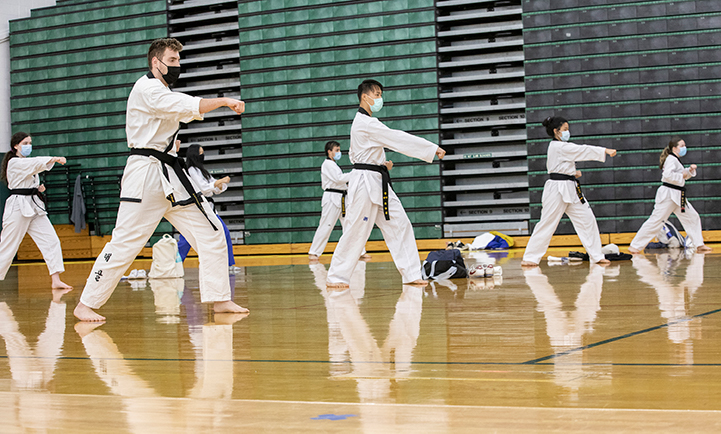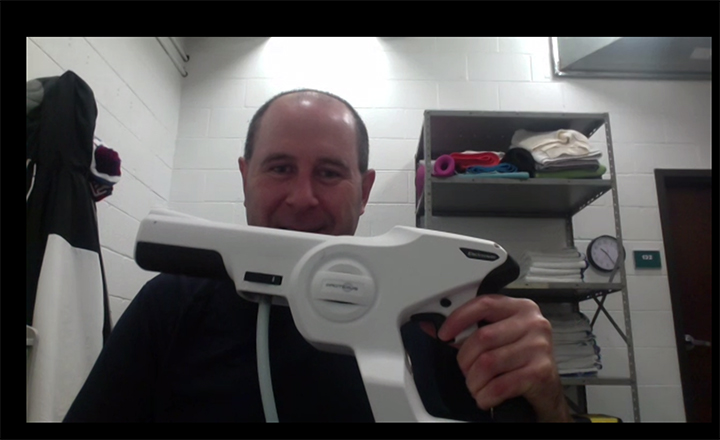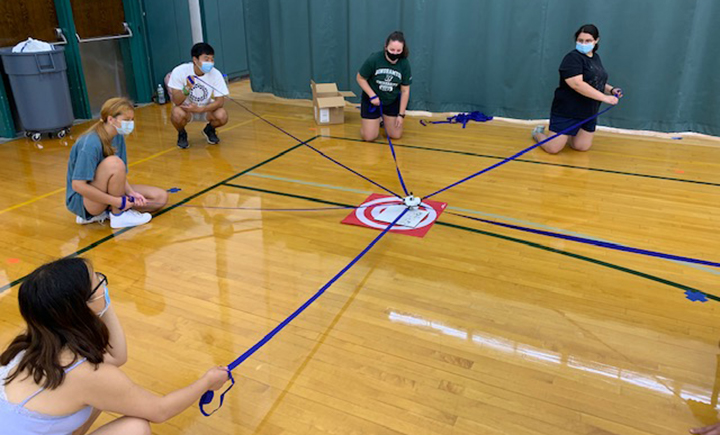Health and wellness faculty keep students positive, connected during pandemic

Each semester, approximately 2,000 Binghamton University students take courses administered through Health and Wellness Studies (HWS), a division within Decker College of Nursing and Health Sciences. HWS offers nearly 60 cognitive- and activity-based courses on topics ranging from lifeguard training, tai chi and running to psychophysiological awareness, stress management and human sexuality.
While the COVID-19 pandemic forced HWS faculty to innovate and adapt to teach classes remotely or in a socially distant way, what stands out is how committed they remained to helping students learn healthy habits and maintain a positive mindset.
“Whether we’re in person or remote, as a faculty we’re sending a message of physical wellness and mental well-being, trying to get students to stay positive, be active and talk about their experience and the challenges they’ve faced during the pandemic,” said Lisa Hrehor, director of HWS.
Adjunct Lecturer Cary Swartz ’00, MA ’01, teaches Wellness Through Weight Training and Physical Fitness and Wellness classes. He said coming up with a way students could complete the physical activities at home without any equipment was one of the many difficulties he dealt with when Binghamton transitioned to remote learning in March 2020.
“It was definitely a challenge because I couldn’t require [students] to get any equipment since very little was available and it would have been an added expense,” Swartz said. “I told them the only thing they needed was a blanket or towel for floor exercises. Then, we had them go into their kitchen cupboards and add something for resistance — cans, milk cartons filled with water, you name it. We improvised, but the students were able to go through the range of motions to learn the exercises.”
Since March, Adjunct Lecturer Danielle Meissner has taught Wellness Through Yoga from her home. She admitted that she struggled with her first few classes. Then, Meissner realized she needed to “show up and try to create an environment where students could come in and exhale,” she said.
Meissner also worked hard to build a community within her virtual classroom.
“Whether we’re in person or online, I tell students that they’re going to get to know each other. They may end up best friends or they may never speak again, but when they come through the door — or on the Zoom screen — I’m looking for them and this is their community.”
Meissner also provided students with a safe space to “unclick” and relax by holding “Happy Hour” virtual meetings on Friday evenings in the spring. Beverages were optional, but the events gave students the chance to chat with her and their classmates.
The University resumed on-campus courses in August, but some students chose to remain remote learners. Additionally, Binghamton paused in-person instruction for two weeks in October, and again the week before Thanksgiving, due to a spike in positive COVID-19 tests. Keeping students connected and engaged throughout this time was a challenge.
In the fall, Hrehor co-taught two sessions of Healthy College Living with Lecturer John Fletcher ’92. The course is aimed at first-year students to help them navigate college while also developing healthy habits.
Since fall 2020 first-year students had an especially difficult time adapting to University life, Fletcher and Hrehor strived to help their students — remote and in-person learners — engage with the University and their fellow students.
“When we started the class, I always welcomed students by saying, ‘Good morning 10:50 class or 12:00 class,’” said Fletcher, who also teaches Introductory Taekwondo, Intermediate Taekwondo and Physical Fitness and Wellness. “Of course, [Hrehor] and I knew all the students’ names, but it gave them a sense of community.”
“A lot of first-year students don’t feel they fit in, that they belong, so we let them know that they’re a part of HWS, they’re part of Binghamton,” Hrehor added. “We also told them, ‘You have a group. You have a home. Without you, this 10:50 class wouldn’t exist.’ As little as it may sound, it was something for them to hold onto.”
Hrehor and Fletcher also made it a point to Zoom with all the students once a week to connect remote learners to the rest of the class. “We didn’t want them to feel alienated or singled out,” Hrehor said.
Swartz, too, had concerns about student well-being and adjusted his fall course curricula.
“During the fall I concentrated more on the students’ mental health,” he said. “We talked a lot about exercise and fitness, but we also talked about how they were doing, how they were feeling and how to put themselves in a healthier place. I also told them that it’s OK for them to be angry or frustrated.”
Swartz also incorporated meditation into his classes, which he hadn’t tried before. Based on the positive feedback he received, however, it may become a permanent addition to his curricula.
HWS Lecturer Sarah Thompson, ’MA 99, taught The Science and Application of Exercise; Healthy Weight, Healthy You; Nutrition; Wellness Through Aerobic Exercise; and Nutrition for Student Athletes in the fall. Some classes were a combination of remote and in-person learners, while others were either all remote or all in person.
She said the early part of the semester was difficult. “I felt at times that I wasn’t connecting the way that I wanted to with my students,” she said.
Among Thompson’s strategies to engage with her students more, as well as help them (and herself) combat Zoom fatigue, she included demonstrations from her kitchen and workouts from both the University’s Nature Preserve and parks across Broome County.
“I wanted to show students that they don’t have to be in a gym or a confined area to exercise,” Thompson said. “There are places you can go out in your community and work out while socially distanced and safe.”
By the end of the semester, Thompson said she “felt like we really created a community and the students looked forward to coming to class.”
HWS courses have always been popular and sometimes difficult to get into, and the demand for classes only worsened during the pandemic.
In the fall, Hrehor increased class sizes to accommodate as many students as possible. And, she doesn’t think things will slow down during Binghamton’s Winter Session (Jan. 4-Feb. 5, 2021).
“I almost doubled what we normally offer in the winter,” she said. “The waitlist for our yoga and stress management classes has been crazy, so I added as many sections as I could.”
HWS doesn’t offer programs leading to a degree, but a minor is available. And interest in that continues to grow as well.
“We’ve got 69 students who will graduate with the HWS minor in spring 2021,” said Hrehor, “and we just accepted 28 more.”
Hrehor is developing three more minors — exercise science/athletic training, health promotion and nutrition. She hopes these new programs will be approved in the next few months.



